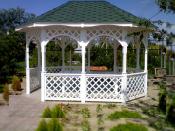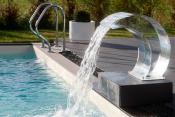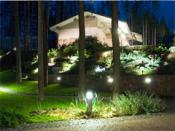Search
Login
Whitewashing of trees, than whitening trees, when to whiten trees, how to whitewash trees properly, useful tips
The tree trunks covered with snow-white paint give the garden a special, festive look. But it is not difficult to guess that gardeners so carefully renew the whiteness of the trunks not at all out of a desire to give the trees a beautiful design. Whitewashing of trees in autumn and spring is carried out in order to protect against burns with ultraviolet rays. It makes sense to figure out exactly when to carry out such work and which working solutions are best used.
Content:
- Why are the trees whitened
- Whitewashing trees in autumn, deadlines video
- The better to whiten (paint) trees
- lime for whitewashing trees
- paint for whitewashing trees video
- Whitewashing of trees with fluff and garden paint, what tools and devices can be used
- We prepare trees for whitewashing correctly video
- Useful tips from experienced gardeners
Why are the trees whitened
The bark for a tree is the same as the skin for humans, it is intended to protect a living organism from the sun and wind, temperature changes, bright sunlight and rodent teeth. The impact of natural factors leads to the fact that over time it becomes rough, cracking and exfoliating. At the same time, its protective functions will decrease, the whole plant will suffer. It is easy to assume that the cortex, as a protective organ, itself needs some protection.

To provide it will help whitewashing, which will save:
- from sunburn in spring and in the second half of winter, the sun at this time is already quite bright, due to the lack of leaves, the rays have direct access to the trunk
- from the influence of a sharp change in temperature, during the off-season, during the day it can change by a dozen degrees, which negatively affects the state of the crust, causing cracks
- from harm caused by insects
- from frost potholes
The whitewashing procedure should be treated responsibly, it is recommended to whiten all the trees, regardless of whether they are garden or decorative.
Whitewashing trees in autumn, deadlines
According to experienced gardeners, it is advisable to carry out processing two, or even three times a year: in autumn, summer, with the beginning of spring. The main thing is autumn whitewashing. The best time is before the start of frost, in the last decade of October.
Autumn whitewash will provide:
- protection against fungal infections and pests that penetrate the cracks of the cortex
- will prevent the formation of frost on it
- to some extent it will frighten off hungry hares - they are unlikely to like to gnaw a lime coating.
If for some reason it was not possible to whitewash the trees in the fall, you will have to do it in February. It is during this period that a dangerous situation arises - warming the unbleached bark to +11 C leads to the awakening of sap flow, but at night the temperature can drop to - 10 C, and a trunk is freezing. During the crystallization process, the juice can break the wood tissue. As a result, frost freezes are formed, which are deeply cracked bark.

The whitewashed surface actively reflects the rays, the surface of the bark warms up much more slowly, the awakening of the tree begins only with the onset of real heat, when the threat of strong night frosts practically disappears.
Even in the case of timely autumn processing, you can not refuse to repeat the procedure in the last days of March.
In summer, whitewashing should be repeated only if the paint has been washed off by showers. In the case of using indelible composition from the summer processing of wood, you can refuse. For work, it is recommended to choose a quiet, sunny day.
The better to whiten (paint) trees
As a whitewash material, you can apply:
- calcareous or chalky solutions
- water-based or water-dispersed garden paint
If you prepare the solution yourself, then it should include three components:
- slaked lime
- clay, wood glue
- a disinfectant, copper sulfate would be quite acceptable

The most common option is the use of a lime solution, it is washed off quickly, and the protection does not provide very reliable, but it attracts with low cost and simple preparation.
lime for whitewashing trees
For self-cooking, you need slaked lime or chalk, based on two to three kilograms per 10 liter bucket of water. You will also need a flour paste or casein glue, about 100 g, about half a kilogram of copper sulfate. Stir the solution until a homogeneous mass is obtained, then insist for several hours.

You can also use another recipe, prepare:
- bucket of water 10 l
- 1 kg of lime
- 1 kg of manure
- 0.2 kg of copper sulfate
All components are mixed, insisted for a couple of hours.
A composition with casein glue will stay on the bark for a longer time. To obtain a working solution, 2 kg of lime are mixed with 400 g of copper sulfate and 100 g of glue. Then pour warm water and insist.

You can replace the glue with oily white clay, 1 kg will be required per bucket of water.
paint for whitewashing trees
The best option for whitewash is garden water-based paint, it creates a moisture-resistant layer that is impervious to sunlight. But it does not clog the pores of the tree, i.e. is vapor permeable.

In addition to color pigment, the paint contains latex, antiseptic substances and modifiers.
Among the advantages of garden paint include:
- ability to not pass ultraviolet radiation
- breathability
- the ability to stay on the cortex for a long time, about 2 years
Whitewashing of trees with water-based garden paint is carried out at a temperature not lower than +3 +4 C, it is advisable to apply the paint in two layers.
You can make paint for whitewashing yourself, but in this case you will need to purchase glue bustilate or any other, on a latex basis. Two parts of glue are added to one part of the coloring pigment (chalk or white clay). The components are mixed, then water is gradually added until the consistency inherent in oil paints is obtained.
Whitewashing of trees with fluff and garden paint - what tools and devices can be used for work
A traditional tool for applying whitewash on the bark is a washcloth brush, but in the today's market for construction tools a lot of convenient products have appeared, these are:
- fly hand brushes, flat, made of artificial bristles,
- mackerel
- flute brushes

Such tools are convenient, thanks to the long bristles the paint is equally easy to apply on smooth and rough surfaces. Some gardeners even use paint rollers for work - it turns out pretty well.

If there are a lot of trees and they are large enough, then the best option would be to use a spray gun.
Correctly preparing trees for whitewashing, useful tips
Trees should be whitened to a sufficiently high height - about 1.8 -2 m, i.e. covered with paint should be not only trunks, but also about a third of the length of skeletal branches.

The whitening process must be preceded by the proper preparation of the tree for this procedure. After choosing a wet day, you should start cleaning the bark of the trunk and branches from moss, lichens and exfoliating pieces of bark. It is not recommended to use any rough tools - there is a risk of damaging the good young bark.
Work should be done by wearing tight gauntlets. To clean the recesses, you can use a wooden knife or a sharp peg. Removed bark fragments are recommended to be burned.
On a sunny, dry day, when nothing portends precipitation, disinfection should be performed.

To do this, bred:
- three percent solution of copper sulfate
- you can use drugs Oxychom, HOM
- Bordeaux fluid.
Processing should be done with a finely dispersed atomizer, it is best if the solution gets onto the surface of the cortex in the form of fog, it must not be allowed to run down the cortex.
Copper-containing preparations are not recommended annually. Copper, accumulating in the bark, can have a negative effect on the plant itself, it will weaken. Treatment with fungicides should be alternated with soap-ash solutions. They perfectly disinfect the surface of the bark, and in themselves are useful for plants.
Solution with soap and ash cooking is very simple. Rub the bar of laundry soap on a grater, weigh 100 g. 6 kg of wood ash are sieved to separate the specks, pour everything into a 20-liter container, pour hot water. After mixing the contents, let it brew and cool.

Bark treatment will be beneficial. ash liquor. For its manufacture, take purified wood ash, fill it with water 1: 4, warm to a boil. Then cool and filter. Before processing trees bred with water. With this solution, you can abundantly spray the bark, or even wash it.
To heal wounds on the cortex, homemade and ready-made compounds are used. Most often this is a talker of clay and water, to give disinfecting properties, you can add copper sulfate, for strength - finely chopped straw. The resulting mixture should have a sour cream consistency.

The second, no less popular tool is garden var. It is sold ready-made in stores for gardeners.
But if you wish, you can make it yourself: by melting the rosin, add beeswax and pork fat to it. When all components are mixed to a homogeneous mass - pour into a container with cold water. After partially cooling - roll into balls. Before applying the var it should be warmed up, it will gain elasticity.
The trading network also has garden pasta rannetenriched with copper sulfate and humate. Since the paste is not resistant to moisture, they are used in good weather.

Having prepared the trees accordingly, proceed to whitewashing. If you need whitewashing of trees so that it doesn’t wash off, use garden paints, if it is possible to repeat the procedure several times a year, use lime or chalk solutions.
Useful Tips
Often you can hear the opinion that only large trees should be whitened, and young seedlings do not require processing, because lime can burn their bark. But experienced gardeners argue that if there is concern about lime, then you need to use paint - it will not cause harm. If you use diluted lime, then the concentration of the mixture should be reduced by half.

Burns received from the sun by young trees can be much more dangerous than from lime.
It is not recommended to apply whitewashing with a very thick layer, having dried up, it can peel off, you will need to redo the work. Recommended layer thickness is within two to three millimeters.
If we talk about how to plant whitewash for trees, it should be noted that it will be necessary to achieve a uniform consistency, the density is equal to sour cream, the presence of lumps of glue or lime is undesirable. The color of the resulting coating should be white - gray will not adequately repel sunlight. You can evaluate whiteness only after the paint has completely dried - when wet, it always has a grayish tint.
It is not necessary to sting the whitewash solution; it is generally recommended to spray its excess around the tree.
A more sustainable effect can be achieved using garden paints, whitewashing is repeated when using a solution of lime and chalk more often.

When making homemade solutions, you can add white clay as an adhesive substance, laundry soap, manure or copper sulfate as an antiseptic.
Practice shows that the systematic whitewashing of fruit trees gives the garden a more decorative look, reduces the incidence of trees, helps increase productivity, which is quite natural - a healthy tree bears fruit better. But most importantly, well-groomed trees live much longer.





